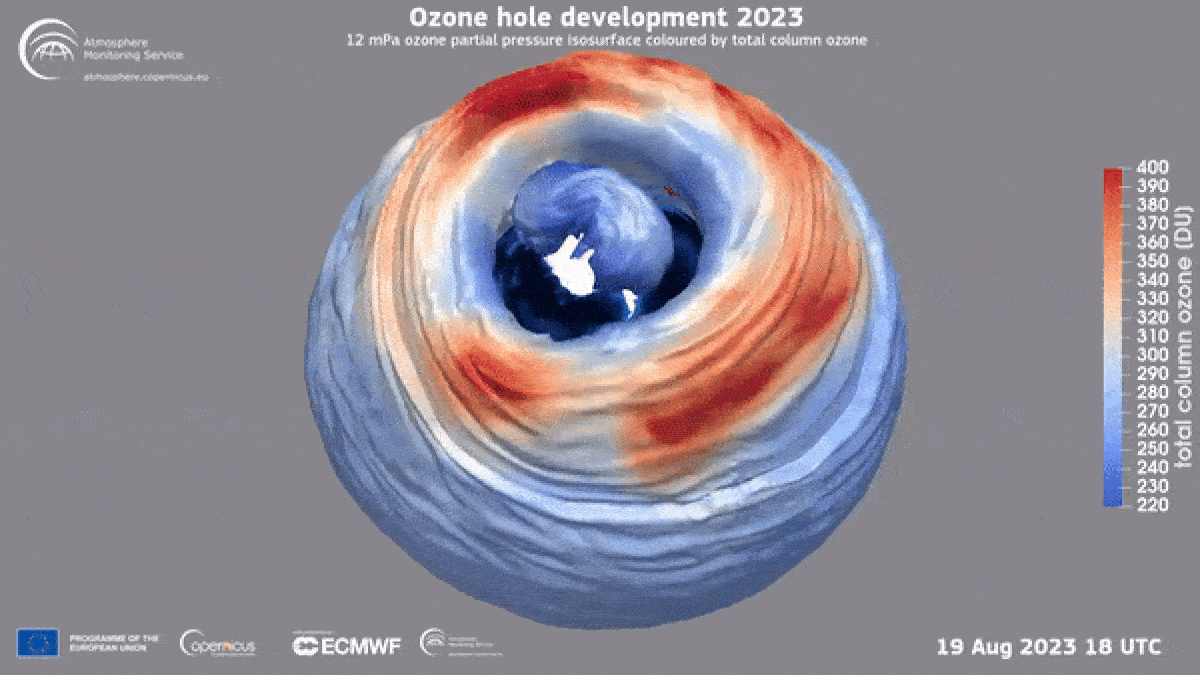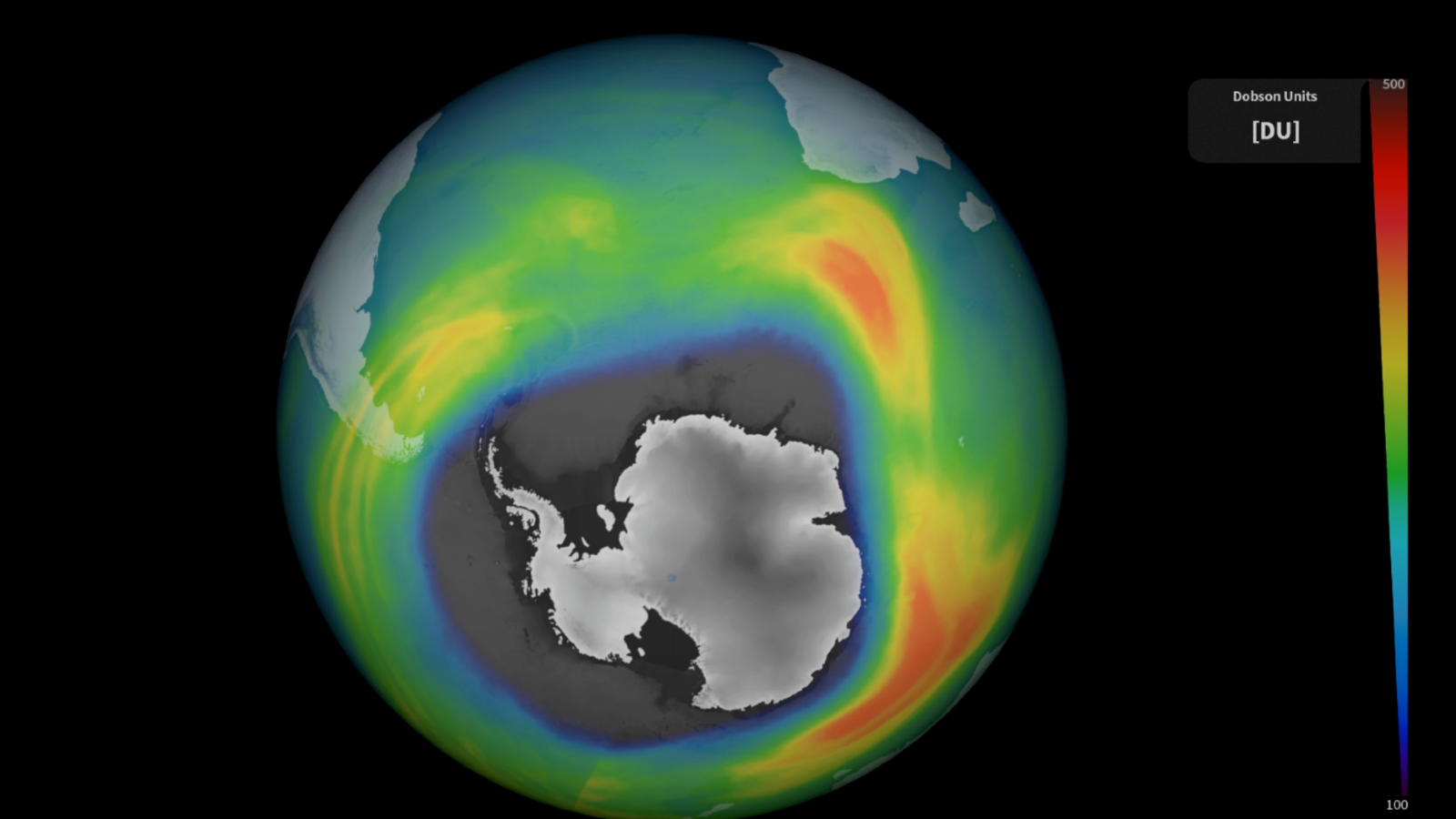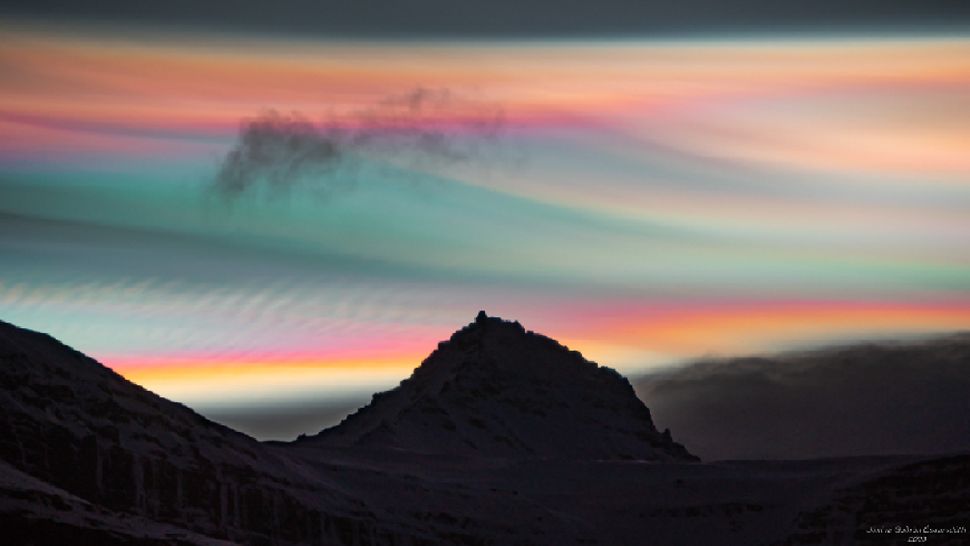
A simulation of this year's ozone hole opening up above Antarctica,
based on data collected by the European Space Agency's Copernicus
Sentinel-5P satellite.
(Image credit: ESA/Copernicus Sentinel data (2023)/processed by CAMS/ECMWF)
(Image credit: ESA/Copernicus Sentinel data (2023)/processed by CAMS/ECMWF)
From LiveSciences by Harry Baker
Satellite data shows that this year's ozone hole grew to around twice the size of Antarctica.
Researchers say the eruption of Tonga's underwater volcano early last year may be partially to blame for the enormous cavity
This year's hole in the ozone layer above Antarctica is one of the biggest ever seen, satellite data shows.
Experts believe the huge gap in Earth's protective shield may have been caused by the eruption of Tonga's underwater volcano in early 2022.
The ozone layer is a band of Earth's atmosphere between 9 and 18 miles (15 and 30 kilometers) above the surface, where there is a high concentration of ozone— a type of oxygen molecule with three atoms instead of two.
The ozone layer blocks out harmful levels of ultraviolet (UV) rays from the sun, which is necessary for various life forms, including humans, to survive.
In 1985, researchers discovered that large holes were appearing in the ozone layer above Earth's polar regions, and that chlorofluorocarbons (CFCs) — a common chemical used in aerosol cans, packing materials and refrigerators at the time — were reacting with the ozone in Earth's atmosphere, depleting ozone levels.
This led to the international community banning CFCs in 1989, allowing ozone levels to recover over time.
However, gaps in the ozone layer still form above the polar regions during each hemisphere's winter months when cold air creates polar stratospheric clouds (PSCs) — extremely high clouds made from tiny ice crystals that sometimes appear to be rainbow-colored — which further deplete the already limited amount of ozone above the poles.
This year's ozone hole above Antarctica reached its maximum size on Sept.
16 when it peaked at a whopping 10 million square miles (26 million square kilometers), according to the European Space Agency (ESA), which monitors the hole with the Copernicus Sentinel-5P satellite.
That is around the same area as North America, three times the size of Brazil, the equivalent of Russia and Chinacombined or around twice the size of Antarctica itself.
Satellite data shows that this year's ozone hole grew to around twice the size of Antarctica.
Researchers say the eruption of Tonga's underwater volcano early last year may be partially to blame for the enormous cavity
This year's hole in the ozone layer above Antarctica is one of the biggest ever seen, satellite data shows.
Experts believe the huge gap in Earth's protective shield may have been caused by the eruption of Tonga's underwater volcano in early 2022.
The ozone layer is a band of Earth's atmosphere between 9 and 18 miles (15 and 30 kilometers) above the surface, where there is a high concentration of ozone— a type of oxygen molecule with three atoms instead of two.
The ozone layer blocks out harmful levels of ultraviolet (UV) rays from the sun, which is necessary for various life forms, including humans, to survive.
In 1985, researchers discovered that large holes were appearing in the ozone layer above Earth's polar regions, and that chlorofluorocarbons (CFCs) — a common chemical used in aerosol cans, packing materials and refrigerators at the time — were reacting with the ozone in Earth's atmosphere, depleting ozone levels.
This led to the international community banning CFCs in 1989, allowing ozone levels to recover over time.
However, gaps in the ozone layer still form above the polar regions during each hemisphere's winter months when cold air creates polar stratospheric clouds (PSCs) — extremely high clouds made from tiny ice crystals that sometimes appear to be rainbow-colored — which further deplete the already limited amount of ozone above the poles.
This year's ozone hole above Antarctica reached its maximum size on Sept.
16 when it peaked at a whopping 10 million square miles (26 million square kilometers), according to the European Space Agency (ESA), which monitors the hole with the Copernicus Sentinel-5P satellite.
That is around the same area as North America, three times the size of Brazil, the equivalent of Russia and Chinacombined or around twice the size of Antarctica itself.
The ozone hole reached its maximum size on Sept.
16.
16.
(Image credit: ESA/Copernicus Sentinel data (2023)/processed by DLR)
"The 2023 ozone hole got off to an early start and has grown rapidly since mid-August," Antje Inness, a researcher at the European Center for Medium-Range Weather Forecasts, said in the statement.
It is "one of the biggest ozone holes on record," she added.
The enormous gap could be attributed to the eruption of the Hunga Tonga-Hunga Ha'apai volcano, which exploded with the force of more than 100 Hiroshima bombs and created the tallest-ever recorded eruption plume when it popped its top in January 2022, researchers said.
In August 2022, a separate group of scientists warned that the eruption could destabilize the ozone layer after more than 50 million tons of water was launched into the upper atmosphere, which is equivalent to a 10% increase in the amount of atmospheric water.
The scientists suggested the water vapor could further destabilize the ozone layer after breaking down into ions, or charged molecules, that react with ozone in a similar way to CFCs.
Water vapor also increases the chance of PSCs forming in polar regions, according to ESA.
It now appears that those scientists were right, Inness said.
But further research is needed to confirm the link between this year's ozone hole and the eruption, she added.
The scientists suggested the water vapor could further destabilize the ozone layer after breaking down into ions, or charged molecules, that react with ozone in a similar way to CFCs.
Water vapor also increases the chance of PSCs forming in polar regions, according to ESA.
It now appears that those scientists were right, Inness said.
But further research is needed to confirm the link between this year's ozone hole and the eruption, she added.
Rainbow-colored polar stratospheric clouds (PSCs) photographed in the Arctic above the peak of Mount Jökultindur in Iceland on Jan. 25 this year.
(Image credit: Jónína Guðrún Óskarsdóttir)
(Image credit: Jónína Guðrún Óskarsdóttir)
The ozone holes above both poles display natural variability that could also play a role in this year's giant cavity.
In 2019, Antarctica's ozone hole shrunk to its smallest size on record, due to unusually warm temperatures that prevented PSCs from forming.
But from 2020 to 2022, the ozone hole grew in size year on year as colder temperatures returned.
This year's El Niño event may also have played a small role in altering temperatures around the poles, but this relationship is unclear at present.
Although the current ozone hole is one of the largest ever seen, there is no reason to panic, ESA researchers said.
The area below the ozone hole is largely uninhabited, and it should fully close up again within a few months.
If CFC levels remain low, then the ozone layer should be fully healed by 2050, they added.
Links :


No comments:
Post a Comment